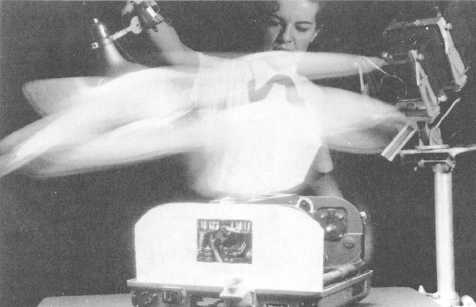Figure 6-11.–Using painted light.
302.187
useful range between highlights and shadows, in which
the film can record detail, must be established. This
useful range depends completely on the reflectance
range of the subject.
With most color films, this range between highlights
and shadows must be kept within five f/stops. This
means a ratio of about 32:1. Any area of the subject
(except specular highlights) that is outside of this range
is reproduced either too light or too dark in the final
picture. A reflected light meter can be used to find the
relationship between the useful or desired diffused
highlight and the darkest desired shadow. A difference
of two f/stops is a scene contrast of 4: 1; four stops is a
16:1 contrast. Most black-and-white film can record
both highlight and shadow detail when this range is not
greater than about six f/stops.
Painted Light
Painted light (fig. 6-11) is one of the best ways to
obtain even illumination and soft shadows. With this
type of lighting, only one light is used. The light is
moved constantly up and down and around the subject
and its background. Painted light is effective for
illuminating subjects made up of many smaller parts that
cast shadows onto adjacent parts, such as printed circuits
or the inside of a radio.
When you are using the painted light technique, the
exposure must be increased by a factor of 3. To
determine the painted light exposure, hold the light
stationary at the same distance it will be used from the
subject. Read the exposure with your light meter.
Multiply the exposure time indicated by the meter by 3,
the painted light factor.
Example: With the light meter, you have determined
the exposure to be 6 seconds. Multiply the exposure
time, 6 seconds, by the painted light factor,
3 (6 x 3 = 18 seconds).
The minimum exposure time required when using
painted light is 10 seconds. An exposure of less than 10
seconds does not give the photographer enough time to
illuminate the subject evenly.
PRODUCT PHOTOGRAPHY
TECHNIQUES
Product photography requires patience and a keen
eye. The slightest change in lighting or subject
placement can add to or subtract dramatically from your
photograph. Pay particular attention to small details of
your photograph because this helps to provide sharp,
high-quality images with fine detail.
6-27



